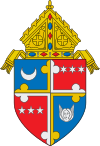Related Research Articles

Michael Francis Egan was an Irish, later American, prelate of the Roman Catholic Church. He was born in Ireland in 1761, and joined the Franciscan Order at a young age. He served as a priest in Rome, Ireland, and Pennsylvania and became known as a gifted preacher. In 1808, Egan was appointed the first Bishop of Philadelphia, and held that position until his death in 1814. Egan's tenure as bishop saw the construction of new churches and the expansion of the Catholic Church membership in his diocese, but much of his time was consumed by disputes with the lay trustees of his pro-cathedral, St. Mary's Church in Philadelphia. He died in Philadelphia, probably of tuberculosis, in 1814.

John Dawson Gilmary Shea was a writer, editor, and historian of American history in general and American Roman Catholic history specifically. He was also a leading authority on aboriginal native Americans in the United States. He is regarded as the "Father of American Catholic History".
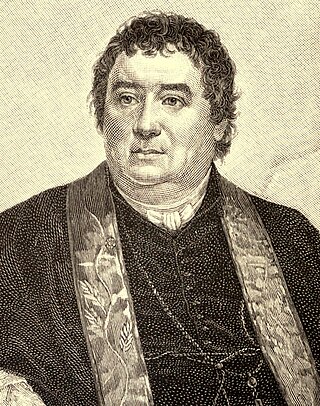
Benedict Joseph Fenwick was an American Catholic prelate, Jesuit, and educator who served as the Bishop of Boston from 1825 until his death in 1846. In 1843, he founded the College of the Holy Cross in Worcester, Massachusetts. Prior to that, he was twice the president of Georgetown College and established several educational institutions in New York City and Boston.
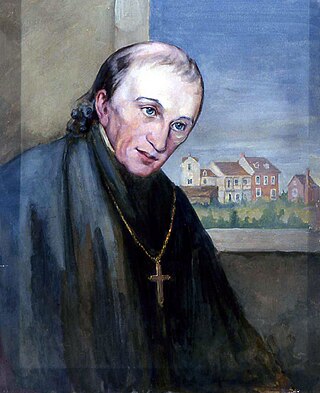
Leonard Neale was an American Catholic prelate and Jesuit who became the second Archbishop of Baltimore and the first Catholic bishop to be ordained in the United States. While president of Georgetown College, Neale became the coadjutor bishop to John Carroll and founded the Georgetown Visitation Monastery and Academy.
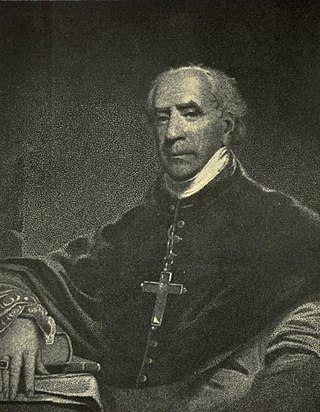
Henry Conwell was an Irish-born Catholic bishop in the United States. He became a priest in 1776 and served in that capacity in Ireland for more than four decades. After the Pope declined to appoint him Archbishop of Armagh, the diocese in which he served as Vicar General, he was instead installed as the second Bishop of Philadelphia in 1819.

Francis Ignatius Neale, also known as Francis Xavier Neale, was an American Catholic priest and Jesuit who led several academic and religious institutions in Washington, D.C., and Maryland. He played a substantial role in the Jesuit order's resurgence in the United States.

Andrew J. Byrne was an Irish-born American Catholic priest, who became the first bishop of the Diocese of Little Rock in Arkansas from 1844 until his death in 1862.

Robert P. Molyneux was an English-American Catholic priest and Jesuit missionary to the United States. Born to a prominent English family, he entered the Society of Jesus and studied at the College of St Omer in France. When the school moved to Bruges, Belgium, he followed, becoming a master. In 1771, he emigrated to the United States as a missionary, where he took up pastoral work in Philadelphia.
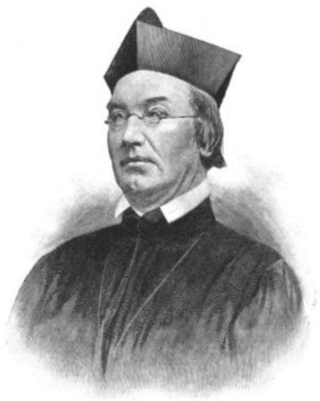
John Early was an Irish-American Catholic priest and Jesuit educator who was the president of the College of the Holy Cross and Georgetown University, as well as the founder and first president of Loyola College in Maryland. Born in Ireland, he emigrated to the United States at the age of nineteen. Upon his arrival, he enrolled at Mount St. Mary's Seminary in Maryland and entered the Society of Jesus, completing his education at Georgetown University in Washington, D.C.
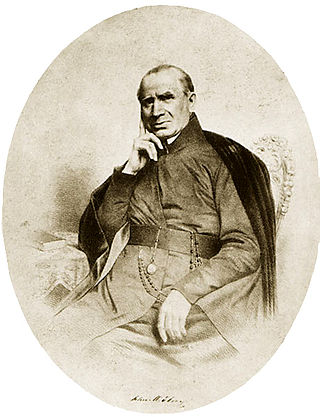
John McElroy was born in Ireland in 1782, and emigrated to the United States in 1803. McElroy enrolled in Georgetown University in 1806, the same year in which he joined the Society of Jesus as a lay brother. His brother Anthony also became a Jesuit. Fr. McElroy assumed the management of Georgetown's financial affairs. He was ordained a priest in 1817. In 1822 he was sent to Frederick, Maryland, where he was to remain for 23 years as pastor of St. John the Evangelist Catholic Church in downtown Frederick. It was in Frederick that he founded St. John's Literary Institution. During the Mexican–American War, McElroy served as an Army chaplain, and on his return from Mexico he went to Boston, where he established Boston College and Boston College High School.

John Carroll was an American prelate of the Catholic Church who served as the first bishop and archbishop in the United States. He served as the ordinary of the first diocese and later Archdiocese of Baltimore, in Maryland, which at first encompassed all of the United States and later after division as the eastern half of the new nation.
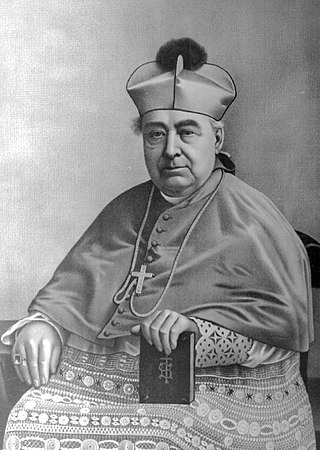
William O'Hara was an Irish-born American prelate of the Catholic Church. He was the first bishop of the Diocese of Scranton in Pennsylvania, serving from 1868 until his death in 1899. He founded St. Thomas College in 1888.

Bishop John Carroll is a statue by the sculptor Jerome Connor commemorating Archbishop John Carroll, the founder of Georgetown University and the first Catholic bishop in the United States. Located in front of Healy Hall, on university's campus in the Georgetown neighborhood of Washington, D.C., the statue consists of a bronze sculpture of Carroll on top of a granite pedestal.

St Patrick's Catholic Church is a Roman Catholic parish in Washington, District of Columbia, United States of America. Established in 1794, it is the oldest Catholic parish in the city of Washington.

William Matthews, occasionally spelled Mathews, was an American who became the fifth Roman Catholic priest ordained in the United States and the first such person born in British America. Born in the colonial Province of Maryland, he was briefly a novice in the Society of Jesus. After being ordained, he became influential in establishing Catholic parochial and educational institutions in Washington, D.C. He was the second pastor of St. Patrick's Church, serving for most of his life. He served as the sixth president of Georgetown College, later known as Georgetown University. Matthews acted as president of the Washington Catholic Seminary, which became Gonzaga College High School, and oversaw the continuity of the school during suppression by the church and financial insecurity.

Bernard A. Maguire was an Irish-American Catholic priest and Jesuit who served twice as the president of Georgetown University. Born in Ireland, he emigrated to the United States at the age of six, and his family settled in Maryland. Maguire attended Saint John's College in Frederick, Maryland, and then entered the Society of Jesus in 1837. He continued his studies at Georgetown University, where he also taught and was prefect, until his ordination to the priesthood in 1851.

Thomas F. Mulledy was an American Catholic priest and Jesuit who became the president of Georgetown College, a founder of the College of the Holy Cross, and a Jesuit provincial superior. His brother, Samuel Mulledy, also became a Jesuit and president of Georgetown.

John William Beschter was a Catholic priest and Jesuit from the Duchy of Luxembourg in the Austrian Netherlands. He emigrated to the United States as a missionary in 1807, where he ministered in rural Pennsylvania and Maryland. Beschter was the last Jesuit pastor of St. Mary's Church in Lancaster, as well as the pastor of St. John the Evangelist Church in Baltimore, Maryland. He was also a priest at several other German-speaking churches in Pennsylvania.
Enoch Fenwick was an American Catholic priest and Jesuit who ministered throughout Maryland and became the twelfth president of Georgetown College. Descending from one of the original Catholic settlers of the Province of Maryland, he studied at Georgetown College in what is now Washington, D.C. Like his brother and future bishop, Benedict Joseph Fenwick, he entered the priesthood, studying at St. Mary's Seminary before entering the Society of Jesus, which was suppressed at the time. He was made rector of St. Peter's Pro-Cathedral in Baltimore by Archbishop John Carroll, and remained in the position for ten years. Near the end of his pastorate, he was also made vicar general of the Archdiocese of Baltimore, which involved traveling to say Mass in remote parishes throughout rural Maryland.
References
- ↑ Shea, John Gilmary (1888). "St. Patrick's Church". Life and Times of the Most Rev. John Carroll, Bishop and First Archbishop of Baltimore: Embracing the History of the Catholic Church in the United States. 1763-1815. John Gilmary Shea. p. 515. ISBN 9780837058641. Archived from the original on September 16, 2018. Retrieved September 16, 2018.
- 1 2 "St. Patrick's". When Washington was Irish. Archived from the original on September 16, 2018. Retrieved September 16, 2018.
- ↑ Diaz, Kevin (March 31, 2000). "God Is in the Real Estate". Washington City Paper . Archived from the original on April 19, 2018. Retrieved April 19, 2018.
- 1 2 MacGregor, Morris J. (1994). A parish for the federal city : St. Patrick's in Washington, 1794-1994 . Washington, D.C.: Catholic University of America Press. ISBN 0813208017. OCLC 29636010.
- 1 2 Warner, William W. (1994). "Part I: Georgetown and the Maryland Tradition". At Peace with All Their Neighbors: Catholics and Catholicism in the National Capital, 1787-1860. Washington, D.C.: Georgetown University Press. pp. 25–26. ISBN 1589012437. Archived from the original on September 16, 2018.
- 1 2 "The Archdiocese and Province of Baltimore". The Catholic Church in the United States of America: Undertaken to Celebrate the Golden Jubilee of His Holiness, Pope Pius X. New York: Catholic Editing Company. 1914. p. 117. Archived from the original on September 16, 2018. Retrieved September 16, 2018.
- ↑ McGreal, Mary Nona (2001). "Chapter 2: Preachers in the Service of Bishop John Carroll" (PDF). The Order of Preachers in the United States: Dominicans at home in a young nation 1786-1865. Vol. 1: A Family History. Editions du Signe. ISBN 9782746805347. Archived (PDF) from the original on September 23, 2015.
